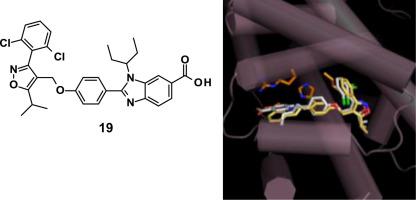Bioorganic & Medicinal Chemistry ( IF 3.5 ) Pub Date : 2020-05-23 , DOI: 10.1016/j.bmc.2020.115512 Arisa Masuda 1 , Keigo Gohda 2 , Yusuke Iguchi 3 , Ko Fujimori 4 , Yukiko Yamashita 3 , Keisuke Oda 3 , Mizuho Une 5 , Naoki Teno 6

|
As a cellular bile acid sensor, farnesoid X receptor (FXR) participates in regulation of bile acid, lipid and glucose homeostasis, and liver protection. With respect to the bone metabolism, FXR positively regulates bone metabolism through both bone formation and resorption of the bone remodeling pathways. Some of FXR agonists possessing isoxazole moiety are undergoing clinical trials for the treatment of non-alcoholic steatohepatitis. To date, therefore, the activation of FXR leads to considerable interest in FXR as potential therapeutic targets. We have identified a series of nonsteroidal FXR agonists bearing N1-methyl benzimidazole and isoxazole moieties that are bridged with aromatic derivatives. They showed affinity to FXR, but also weak affinity toward the vitamin D receptor (VDR) that involves regulation of calcium and phosphate homeostasis and is activated by bile acids. The deployment of FXR agonists without activity against VDR as off-target is therefore crucial in the development of FXR ligands. Our efforts focusing on increasing the agonist properties towards FXR led to the discovery of 19, which activates FXR at and below nanomolar levels (EC50 = 26.5 ± 10.5 nM TR-FRET and 0.8 ± 0.2 nM luciferase, respectively) and functions as a FXR agonist: the affinity toward FXR over eight nuclear receptors, including VDR [IC50 (VDR) / EC50 (FXR) > 5000] and TGR5, effects FXR target genes, and activates bone morphogenetic protein-2-induced differentiation of mouse bone marrow-derived mesenchymal stem cell-like ST2 cells into osteoblast.
中文翻译:

N1取代的苯并咪唑支架用于法尼醇X受体(FXR)激动剂,并具有对维生素D受体(VDR)的显着选择性。
作为一种细胞胆汁酸传感器,法呢素X受体(FXR)参与胆汁酸,脂质和葡萄糖体内稳态以及肝脏保护的调节。关于骨骼代谢,FXR通过骨骼形成和骨骼重塑途径的吸收来积极调节骨骼代谢。一些具有异恶唑部分的FXR激动剂正在接受临床试验,以治疗非酒精性脂肪性肝炎。因此,迄今为止,FXR的激活引起了对FXR作为潜在治疗靶标的极大兴趣。我们确定了一系列带有N 1的非甾体FXR激动剂-与芳族衍生物桥接的-甲基苯并咪唑和异恶唑部分。他们对FXR表现出亲和力,但对维生素D受体(VDR)的亲和力却很弱,这涉及钙和磷酸盐稳态的调节,并被胆汁酸激活。因此,没有针对VDR的脱靶活性的FXR激动剂的部署对于FXR配体的开发至关重要。我们致力于增加对FXR的激动剂特性的努力导致了19的发现,它可以在纳摩尔水平或更低的纳摩尔水平(分别为EC 50 = 26.5±10.5 nM TR-FRET和0.8±0.2 nM荧光素酶)激活FXR,并作为FXR激动剂:对包括VDR在内的8种核受体对FXR的亲和力[IC 50(VDR)/ EC 50 (FXR> 5000)和TGR5,影响FXR目标基因,并激活骨形态发生蛋白2诱导的小鼠骨髓间充质干细胞样ST2细胞分化为成骨细胞。


























 京公网安备 11010802027423号
京公网安备 11010802027423号